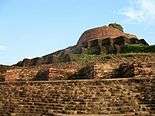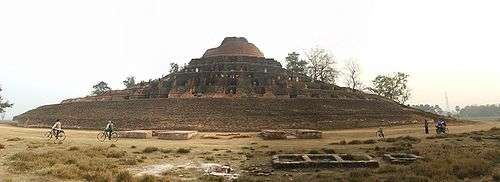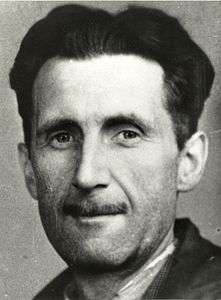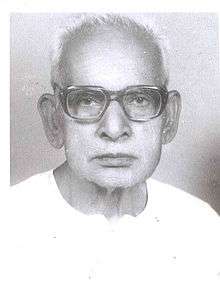Motihari
| Motihari मोतिहारी موتیہاری | |
|---|---|
| City | |
 Motihari Location in Bihar, India | |
| Coordinates: 26°39′00″N 84°55′00″E / 26.65000°N 84.91667°ECoordinates: 26°39′00″N 84°55′00″E / 26.65000°N 84.91667°E | |
| Country |
|
| State | Bihar |
| District | East Champaran |
| Founded by | Government |
| Government | |
| • Type | Democracy |
| • Body | Democratic |
| Elevation | 62 m (203 ft) |
| Population (2011[1]) | |
| • Total | 145,158 |
| Languages | |
| • Official | Bhojpuri, Hindi |
| Time zone | IST (UTC+5:30) |
| PIN | 845401 |
| Telephone code | 06252 |
| Vehicle registration | BR-05 |
| Lok Sabha constituency | Purvi Champaran |
| Vidhan Sabha constituency | Motihari |
| Website |
eastchamparan |
Motihari is the headquarters of East Champaran district (Purbi Champaran district) (Tirhut Division)[2] - (Tirhut) in the Indian state of Bihar. It is one of the important towns of Bihar.
History
In 1866 Champaran district was formed with Motihari as its headquarters. On 1 December 1977, the Champaran district was divided into the districts of Purvi Champaran (East Champaran) and Pashchimi Champaran (West Champaran). Motihari and Bettiah became headquarters of East Champaran and West Champaran districts respectively.
The municipality of Motihari was established in 1879. Though no authentic data is available, one of the oldest structures in Motihari appears to be the Briksha Sthan Math, a temple of the guardian deity of Motihari, dating back to 1805. During the British era, the town flourished and it became one of the important centers of North Bihar. Mahatma Gandhi came to Champaran to see the condition of farmers who were forced by the British to cultivate indigo in place of food grains. Later on, Mahatma Gandhi started his satyagraha aandolan for indigo farmers against English.
Geography
Motihari is around 165 km northwest from Patna, the capital of Bihar, 45 km from Bettiah, and 72 km from Muzaffarpur. The city is close to Nepal. Birgunj, the second largest town of Nepal, is 55 km away. The closest villages are Madhubani ghat, Sirsha, and Pataura. The river Burhi Gandak flows nearby.
Demographics
As of 2011 India census,[3] and As per provisional reports of Census India [8], the population of Motihari in 2011 was 125,183; of which male and female are 67,438 and 57,745 respectively. The sex ratio of Motihari city is 856 per 1000 males.
Total literates in Motihari city are 94,926 of which 52,904 are males while 42,022 are females. The average literacy rate is 87.20 percent of which male and female literacy was 90.36 and 83.52 percent.
The children aged 0–6 in Motihari city are 16,325, as per the Census India report, in 2011. There were 8,891 boys and 7,434 are girls. The child sex ratio of girls is 836 per 1000 boys.
Climate
Climate is characterized by high temperatures and evenly distributed precipitation throughout the year. The Köppen Climate Classification sub-type for this climate is "Cfa" (Humid Subtropical Climate).
| Climate data for Motihari | |||||||||||||
|---|---|---|---|---|---|---|---|---|---|---|---|---|---|
| Month | Jan | Feb | Mar | Apr | May | Jun | Jul | Aug | Sep | Oct | Nov | Dec | Year |
| Average high °C (°F) | 22 (72) |
26 (78) |
31 (88) |
34 (93) |
36 (96) |
34 (93) |
32 (90) |
32 (90) |
32 (89) |
30 (86) |
27 (80) |
23 (74) |
30 (86) |
| Average low °C (°F) | 8 (47) |
11 (51) |
15 (59) |
21 (69) |
24 (75) |
26 (79) |
26 (79) |
26 (79) |
25 (77) |
21 (69) |
13 (56) |
9 (48) |
19 (66) |
| Average precipitation mm (inches) | 23 (0.9) |
10 (0.4) |
30 (1) |
43 (1.7) |
71 (2.8) |
201 (7.9) |
437 (17.2) |
280 (11) |
250 (10) |
100 (4) |
5 (0.2) |
0 (0) |
1,450 (57) |
| Source: Weatherbase[4] | |||||||||||||
Transport
One can reach Motihari by rail and road services.The nearest airport is at patna,about 150 km.
Railways
Bapudham Motihari railway station is an A grade category railway station and is one of the busiest stations of Samastipur railway division. It is connected to some major cities of India viz Kolkata, Delhi, Haridwar, Dehradun, Mumbai, Amritsar, Kanpur, Guwahati, Jammu, Ahmedabad, Jaipur, Porbandar, Lucknow, Patna, Muzaffarpur, Darbhanga and Bareilly.
Roadways
Motihari is connected with Muzaffarpur, Lucknow,and Kathmandu by National Highway 28. Bus services are available to Muzaffarpur, Patna, Darbhanga, Kathmandu , Ranchi, Jamshedpur.
Notable people
George Orwell, author of Animal Farm and Nineteen Eighty-Four, was born in Motihari in 1903. His father, Richard Walmesley Blair was a deputy posted in the opium department in Bihar. When he was one year old, George left for England with his mother and sister. Until recently, the town of Motihari was largely unaware of its connection with Orwell. In 2003, Motihari discovered its role in Orwell's life when a number of journalists arrived in the town for Orwell's hundredth birthday. Local officials are making plans for the construction of a museum on Orwell's life.[5][6][7] The museum plans remain in abeyance in 2014.[8]
Khan Bahadur Azizul Huq was one of the two Indian police officers who worked with Edward Henry in the development of fingerprint classification, known as the Henry Classification System, died in Motihari in 1933. "It was Khan Bahadur Azizul Huq who evolved a mathematical formula to supplement Henry's idea of sorting slips in 1024 pigeon holes, based on fingerprint patterns. Rai Bahadur Hem Chandra Bose made further contribution to the fingerprint science by evolving an extended system of sub classification, a telegraphic code for finger impression and a system of single-digit classification."[9] Both Haque and Bose eventually received honoraria and recognition from the Government of India. At the time of final approval of the honorarium for Haque, the Home Department (Government of India) noted, "It appears from the information now received that he (Haque) was Sir Edward Henry's principal helper in perfecting the scheme and he actually himself devised the method of classification which is in universal use. He thus contributed most materially to a discovery which is of worldwide importance and has brought a great credit to the police of India."[10] Upon retirement from the Police service in Bengal and Bihar, Khan Bahadur Azizul Huq settled in Motihari, and he is buried there.
A.F.Salahuddin Ahmed, National Professor of Bangladesh, a grandson of Khan Bahadur Azizul Huq was born in Motihari in 1924. He was educated at Presidency University, Kolkata, University of Pennsylvania, and University of London, and taught at eminent universities in Bangladesh: Jagannath College, Rajshahi University, Jahangir Nagar University, Dhaka University, and Independent University,Bangladesh, and wrote many books and articles in professional journals and newspapers. In one of his books, Perspectives on History, Society and Politics, he argued that despite the political divisions that took place in South Asia in 1947, the people of this vast region belong to “one indivisible civilization which is the product of over a thousand years of historical development” and that the destinies of the people inhabiting the subcontinent are closely interlinked. They must therefore learn to live together in peace, as this is essential for their development and progress.
The modern Hindi poet, author and freedom fighter Ramesh Chandra Jha belonged to Phulwariya village in Motihari.

Thakur Ramapati Singh was a freedom fighter, MLA. Minister, and MP from Motihari. Ram Behari Sharma, Advocate of the Supreme Court Of India, High Court Of India,Civil Court), freedom fighter, founder of Women's College,Motihari
Tourism
Kesaria
Kesaria has the tallest and the largest Buddhist stupa in the world. The stupa was discovered in 1998 during an excavation exercise conducted by the Archaeological Survey of India (ASI). The stupa dates back to the era between 200 AD and 750 AD and may have been associated with the 4th century ruler, Raja Chakravarti. At 104 feet, Kesaria Stupa is one foot taller than the Borobodur Stupa in Java. It is also taller than the second largest stupa at Ghorakatora in the Nalanda district. The National Informatics Centre of East Champaran (Motihari) suggests the Kesaria Stupa was 123 feet tall before the 1934 earthquake in Bihar. According to a report by the A.S.I., the Kesaria Stupa was originally 150 feet in height. The height of Sanchi Stupa a world heritage site is 77.50 feet.
The largest Hindu temple in the world - Virat Ramayan Mandir - will be 2268 ft. in length, 1296 ft. in width and 440 ft. in height. It will be located at Janaki Nagar, near Kesaria in North Bihar, 120 km. from Patna and 60 km. from the historic town of Vaishali. It will be spread across an area of 200 acres on the Kesaria Chakia main road, near Kathwalia-Bahuara village.
Like other south-east Asian temples it will have layers instead of floors and in the first layer the visitor would have to walk more than a kilometre to see four temples with shikhars (spires) in the four corners. In the last layer the main Rãma temple consisting of Rãma, Sitã, Lava, Kusha and Valmiki will be at a height of 66 ft. with will have a sitting capacity for 20 thousand devotees at one time. In all there will be 18 temples with high spires. The Shiva temple will comprise the largest lingam in the world.
The Hanuman (Mahavir) Mandir trust at Patna, after having established four charitable hospitals in the capital of Bihar, has undertaken the construction of the largest Hindu temple in the world to be called the 'Virat Ramayan Mandir' which will be larger than the Angkor Wat temple situated in Cambodia, considered the largest Hindu temple for centuries. Assets of the temple and its institutions are estimated at Rs. 300 crore. The cost of the 'Virat Ramayan Mandir' project will be around Rs. 500 crore. The temple trust provides Rs. 1 crore every year for the treatment of poor cancer patients and towards the running expenditure of other hospitals run by the temple trust.
Gandhi Smarak (Motihari)
The foundation stone of the Gandhi memorial pillar was laid on 10 June 1972 by the then Governor, Mr. D.K.Barooch and dedicated to the nation by Mr. Vidyakar Kavi, a Gandhian, on 18 April 1978. The memorial pillar was designed b
Moti Jheel
Moti Jheel is the heart of Motihari. This is a lake and canal in the heart of the city of Motihari. It divides Motihari into two sections. Spectacular views are available for visitors on either side of the canal. A flyover has been opened to allow the public to commute more easily. It resolves travel issues near the railway crossing.
Lauria (Areraj Lauria)
The Lauria is 2 kilometers away from Areraj on the Betia-Areraj road. Emperor Asoka had built a Pillar known as Ashok Satambh. The pillar which is also known as "Stambh dharma lekh" bears the edict of Emperor Ashok. It is believed that this Ashok Satambh is 36 feet high with 37.6 inches of base weighs 40 tons. It seems the ASI department of India has taken the top or crown part of this Ashok Satambh, statue of Lion has been deposited in Kolkata museum.
Areraj is a historic place, known for a famous temple called Shri Someshwar Nath Mandir, It is believed that this temple was established by Lord Chandra I.e The Moon, nevertheless Millions of Shiv Bhakt arrive every year on the occasion of Mahashivratri from all over the country. Five kelometers towards east a small village Fatuha a place of inspiration, Shree Bhabhikshan Shah, was a freedom fighter and sent to jail during Indigo Movement of Mahatma Gandhi. His younger son Shree Ram Lal Shah is a social worker, working for the development of minorities. His grandson Dr. S.N. Prasad (M.Sc,Bot.).
Kesaria
Kesaria is a town in Bihar in the district of East Champaran, near Rampur Khajuria (NH28). It is the site of a stupa built by the King Ashoka. It is one of the largest stupas in India.
Lord Buddha once stayed in Kesariya (then called "Kesaputta"). On that occasion, he preached the Kesaputtiya Suttas (a group of sutras preached to the Kalamas of Kesaputta - A.i.188), which include the Kalama Sutta.[11] The inhabitants of Kesariya were the Kosalans and the Kalamas.
Kesaria Stupa Kesaria is claimed to be the tallest and the largest Buddhist Stupa in the world. The stupa was discovered in 1998 during an excavation by the Archaeological Survey of India (ASI). The stupa dates back to the era between 200 AD and 750 AD and may have been associated with the 4th century ruler, Raja Chakravarti.[12]
Height At 104 feet, Kesaria Stupa is one foot taller than the Borobodur Stupa in Java. It is also taller than the second largest stupa at Ghorakatora in the Nalanda district.[13] The National Informatics Centre of East Champaran (Motihari) suggests the Kesaria Stupa was 123 feet tall before the 1934 earthquake in Bihar. According to a report by the A.S.I., the Kesaria Stupa was originally 150 feet in height. The height of Sanchi Stupa a world heritage site is 77.50 feet.
Transportation and hotels at Kesaria Bihar State Tourism Development Corporation[14] provides travel and accommodation from the state capital, Patna, for visits to the Buddhist circuit (Bodhgaya, Rajgir, Nalanda, Vaishali, Kesaria, Lumbini, Kushinagar, Sarnath), Jain Circuit (Rajgir, Pawapuri), and Sikh Circuit in Bihar. The corporation owns hotels and circuit homes at these tourist destinations.
Gallery
 The Kesariya Stupa
The Kesariya Stupa The Kesariya Stupa
The Kesariya Stupa The Kesariya Stupa
The Kesariya Stupa
Mehsi
Mehsi is a small town located in the East Champaran district of Bihar state. Mehsi is an entry point to East Champaran for travellers from Patna, Muzaffarpur to Raxaul, connected both by railway and roadway. Mehsi is famous for pearl button industry which is made from oyster shell available in the river Sikarahana. There are many button factories, a small scale industry, although most of the people depend upon agriculture and commerce. Mehsi is also known for litchi. Litchi is cultivated across most of the area and is main source of income for many people.
Raxaul
Raxaul is a major town in the district of East Champaran and is the border town between India and Nepal. The town is known as the Gateway to Nepal. It is connected by NH28A and is 32 km away from Chhapawa (on NH28A), 52 km from Motihari (the District Town) and 60 km from Bettiah - the District town of West Champaran. Birganj - the Second Big City of Nepal is 3 km away from this town.
School
- G.D.S. Academy - English medium up to 10+2 C.B.S.E Affiliated.
- Cambridge Public School.
- Duncon Academy.
- K.H. School.
- Sarsawati Vidhya Mandir
Ramgarhwah
15 kilometer from Raxaul and 17 kilometer from Chapwa.15 kilometer from Sugauli. HPCL has set up a sugar plant 15 kilometer from Ramgarhwah. Ramgarhwah station is 2 kilometers from Ramgarhwah city.
Adapur
12 kilometer from Raxaul and situated near Nepal border, have small scale industries like rice mills and bricks industries. also known for its well established clothing market.Shops like Shree vastralaya, pavan Vastralaya is pride for this market and frequent visit of nepalies can be seen in this area. low level machali palan is also a source of income for poor people's.
Education
Motihari has many educational institutes like:
- M.S. Memorial Public School , Motihari
is the best school in east champaran.
- Munshi Singh Mahavidyalaya, affiliated to Babasaheb Bhimrao Ambedkar Bihar University is one of the oldest degree colleges in Champaran.
- Lalit Narayan Dubey Mahavidyalaya, affiliated to [B.R.A.Bihar University]
- Pandit Ugam Pandey Mahavidyalaya, affiliated to [B.R.A.Bihar University]
- S.N.S College, Motihari.
- Zila Government School is one of the oldest secondary high schools of Bihar, established in 1911 by the British government.
- Government Teacher Training College Dariyapur.
- Mangal Seminary (1927).
- Gopal Sah Vidyalaya (1918).
- M.J.K. Girls High School.
- Gopal sah Vidyalay (previously this was Hakok Academy: in this hostel George Orwell was born).
- Kendriya Vidyalaya Motihari, Opened in 2003
- St.
- Rajiv Gandhi Memorial Secondary School, Belbanwa.
Central University of Bihar
On 13 June 2012, the Government of India announced the setting up of the Central University of Bihar at Motihari. This would be the second central university in Bihar besides the one at Gaya.[15]
Motihari College of Engineering
An engineering college named as Motihari College of Engineering was established by the Bihar Government. It is now affiliated with the recently formed Aryabhatta Knowledge University, Patna. M. It is under the administrative control of the Department of Science and Technology and wholly funded by the government of Bihar. It offers undergraduate courses in four streams of engineering. The institute caters to the research and development activities of the state of Bihar.
Colleges for higher learning include Mahila College, ANS College, S.N.S. College, L.N.D. College, and K.T.College near Singhiya gumti. All are affiliated to Babasaheb Bhimrao Ambedkar Bihar University. The College of Ayurvedic and Unani Medicine (Homeopathy Medical College, Motihari) provides medical education.
Colleges of Motihari and East Champaran district are
- Dariya Pur Government Teacher Training College Dariya Pur.
- Motihari College of Engineering.
- R.N.M. Ayurved College (Ravindra Nath Mukharjee Ayurved Mahavidyalaya).
- Dr. S. P. Singh College Of Teacher Education.
- M.S. College (Munshi Singh College), Chandmari, Motihari.
- LND College (Laxmi Narayan Dubey College), Sri Krishna Nagar.
Public schools in the town are:
- M.S. Memorial Public School,Balganga,Motihari
- St.Xavier's High School, Awdhesh Chowk NH-28 Near Janpul.
- Delhi Public School JUBLIE, Janpul
- Jeewan Public School, Chandmari.
- Modern Public School, Chandmari.
- Shantiniketan Jubilee school, Shantipuri.
- Jawahar Navodaya Vidyalaya(J.N.V East Champaran) situated at Pipra kothi (13 km away from Motihari).
Industries
Industries in Motihari sub-division are mostly small-scale such as a paper factory, a sugar mill, and some other small-scale industries. A sugar factory is under development in Sariyatpur which will produce sugar, ethanol and electrical power. Motihari’s sugar mill is one of the largest in Bihar. In the villages surrounding Motihari, most people's livelihood depends on agriculture and dairy products. The Motihari area is also known for its litchi fruit and Mitha Alua (sweet potatoes).
Media
Motihari has an All India Radio Rely station known as Akashvani Motihari. It broadcasts on FM frequencies.
- Anuranjan Jha, Eminent Journalist,TV anchor and Social Worker.
- Ravish Kumar, TV anchor and journalist, NDTV Delhi.
- Radha Mohan Singh, Union Minister of Agriculture.
- Sushil Kumar(The First Contestant of KBC winning the prize amount of 50 million).
References
- ↑ http://www.census2011.co.in/census/city/159-motihari.html
- ↑ http://tirhut-muzaffarpur.bih.nic.in
- ↑ "Census of India 2001: Data from the 2001 Census, including cities, villages and towns (Provisional)". Census Commission of India. Archived from the original on 2004-06-16. Retrieved 2008-11-01.
- ↑ "Weatherbase.com". Weatherbase. 2013. Retrieved on 31 July 2013.
- ↑ "All’s not well with Orwell" by Debashis Bhattacharyya The Telegraph (Calcutta, India), 14 November 2004
- ↑ "Makeover for Orwell's India home" by Amarnath Tewary, BBC News (Motihari, Bihar), 1 August 2005
- ↑ "Big Brother can't be bothered " Times of India
- ↑ Haleem, Suhail (12 August 2014). "The Indian Animal Farm where Orwell was born". BBC. Retrieved 2014-08-12.
- ↑ Tewari RK, Ravikumar KV. History and development of forensic science in India. J. Postgrad Med 2000,46:303-308.
- ↑ Sodhi, GS, & Kaur,JK:The forgotten Indian pioneers of fingerprint science
- ↑ http://www.buddhist-temples.com/bihar/kesaria-stupa.html
- ↑ http://www.buddhist-pilgrimage.com/kesaria-stupa.html
- ↑
- ↑ Bihar Tourism
- ↑ Two CUBs in Bihar-Gaya and Motihari

